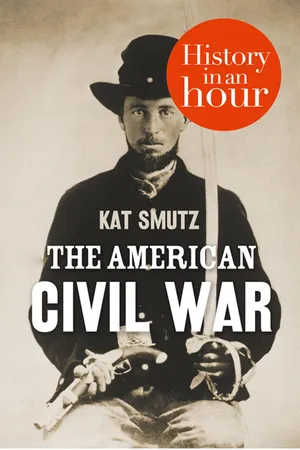
This is a test
- English
- ePUB (mobile friendly)
- Available on iOS & Android
eBook - ePub
The American Civil War: History in an Hour
Book details
Book preview
Table of contents
Citations
About This Book
Love history? Know your stuff with History in an Hour.
The American Civil War started when eleven southern ‘slave’ states declared their independence from the United States of America. Abraham Lincoln’s Republican government were strongly against slavery and fought to abolish it and keep the country united.
The American Civil War: History in an Hour gives a concise and authoritative overview of these four years of bloody and devastating warfare to help you understand how the Civil War shaped America today and changed the history of slavery forever.
Know your stuff: read concise history of the tumultuous struggle between the Confederates and the Union in just one hour.
Frequently asked questions
At the moment all of our mobile-responsive ePub books are available to download via the app. Most of our PDFs are also available to download and we're working on making the final remaining ones downloadable now. Learn more here.
Both plans give you full access to the library and all of Perlego’s features. The only differences are the price and subscription period: With the annual plan you’ll save around 30% compared to 12 months on the monthly plan.
We are an online textbook subscription service, where you can get access to an entire online library for less than the price of a single book per month. With over 1 million books across 1000+ topics, we’ve got you covered! Learn more here.
Look out for the read-aloud symbol on your next book to see if you can listen to it. The read-aloud tool reads text aloud for you, highlighting the text as it is being read. You can pause it, speed it up and slow it down. Learn more here.
Yes, you can access The American Civil War: History in an Hour by Kat Smutz in PDF and/or ePUB format, as well as other popular books in Historia & Historia de la Guerra de Secesión. We have over one million books available in our catalogue for you to explore.
Information
Topic
HistoriaAppendix 1:
Key Players
Key Players
Abraham Lincoln (12 February 1809–15 April 1865)
A self-educated lawyer from Illinois, Abraham Lincoln had been involved in politics for a number of years before he was nominated to run for president by the newly formed Republican Party. Because of his outspoken opposition to slavery, Southern slaveholders feared that if Lincoln became president, his first act would be to ban slavery. When Lincoln was elected in November 1860, the State of South Carolina seceded from the United States. Ten other states followed to form the Confederate States of America.
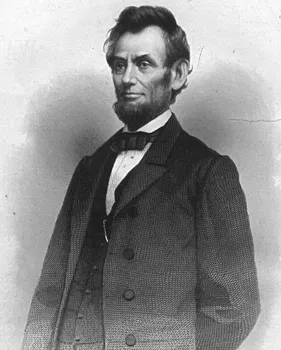
Abraham Lincoln, by D. Van Nostrand
The Confederacy repeatedly insisted that they wanted to be left in peace. But when the Union refused to surrender fortifications in the Confederate States, war erupted.
Lincoln’s priority was the preservation of the Union, and holding the fledgling country of the United States together. He refused to acknowledge South Carolina’s right to secede and prepared for war. Over the next four years, he looked for a general who could lead the army to a speedy victory while he performed a balancing act with the politics and personal interest groups that descended upon Washington. His generals included Winfield Scott, George B. McClellan, Henry Hallack, and finally, Ulysses S. Grant. His first choice, at the recommendation of his first commander-in-chief, Winfield Scott, had been Robert E. Lee, but Lee chose to become commander-in-chief of the Confederate army instead.
In November 1862, Lincoln drafted the Emancipation Proclamation, a document that freed slaves held within the Confederate States. It went into effect on 1 January 1863 and paved the way for the Thirteenth Amendment which outlawed slavery in the United States entirely.
While attending a dedication ceremony at Gettysburg, Pennsylvania, Lincoln gave his famous Gettysburg Address. Although he was not the guest speaker, as president he was asked to speak and delivered his comments in less than two minutes.
In 1864, Lincoln was nominated to run for re-election and won. As a moderate Republican, he was at odds with the radical element of his party who wanted the South punished for their impertinence of attempting to separate themselves from the country. Lincoln wanted reconciliation between the North and South, and encouraged a speedy recovery from the destruction the South had suffered for four long years.
The strain of responsibility took its toll on Lincoln. During his time in the White House, he was known to have suffered periods of depression and fatigue. Amid the turmoil of war and politics, his son, Willie, died aged eleven, while Lincoln was in office. The Lincolns had already lost one child to tuberculosis in 1850. His wife, Mary Todd Lincoln, was a Southern belle from a slaveholding family in Kentucky. It made things difficult for her as a First Lady in a Union-held capital city.
On 14 April 1865, just days after the surrender of Lee at Appomattox, Mary urged her husband to attend a play at Ford’s Theatre. The play, Our American Cousin, was a comedy that the First Lady hoped would lift her husband’s spirits. As Lincoln sat in his box that night, John Wilkes Booth, an actor and fanatical Southern sympathizer, slipped into the box and shot Lincoln in the back of the head. Lincoln was carried across the street to a house where he died at 7.22 the following morning.
With Lincoln gone, his successor, Andrew Johnson, tried to enforce Lincoln’s plans for the South. He was no match for the Radical Republicans who pushed through their policies. During Lincoln’s lifetime, Southerners had despised him and seen him as a threat but after his death, more than few were heard to comment that the South had lost its best friend.
Jefferson Finis Davis (3 June 1808–6 December 1889)
Jefferson Finis Davis was among the many graduates of the United States Military Academy at West Point who found themselves on opposite sides when war came to their own country. Davis was a senator at the outbreak of the war, and it was he who announced to the US Senate that his home state of Mississippi would be withdrawing from the Union. Davis attended the convention in Montgomery, Alabama, where the provisional government for the Confederate States of America was formed. Davis was hoping for a commission as commander of a military unit. Instead, he found himself the provisional president of the seceded states. When general elections were held, he was elected to serve for the full term of six years. He was the Confederacy’s first, last and only president.
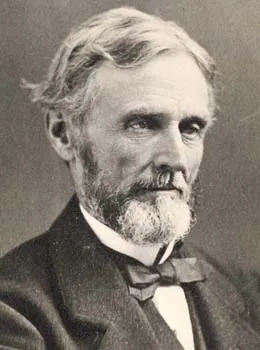
Jefferson Finis Davis
One of Davis’ first acts as president of the Confederacy was to appoint a peace commission. Their job was to travel to Washington DC to negotiate payment for any Federal facilities in the South along with the South’s share of the national debt. The bombardment of Fort Sumter, South Carolina came before the commission had set out for Washington. Any hope of a peaceful secession was gone.
Although Davis was better suited to life of warfare than of politics, he failed to find a strategy to defeat the Union, which was bigger, stronger and better organized. The North was industrialized while the South was agrarian. The North had been training armies for almost a hundred years while the South was starting from scratch. The support of foreign countries would have been helpful, but none were prepared to officially support the Confederacy.
After Lee’s surrender at Appomattox in April 1865, Davis was arrested and charged with treason. He was held at Fort Monroe for two years before being finally released. The charges against him were later dropped.
After the war, Davis travelled and wrote two books – The Rise and Fall of the Confederate Government and A Short History of the Confederate States of America.
Two months after the completion of the second book, he died in New Orleans, Louisiana, of an undetermined cause. He was eighty-one.
George B. McClellan (3 December 1826–29 October 1885)
George B. McClellan was another West Point graduate who went on to a successful military career. He commanded a company of engineers in the Mexican-American War and was an engineering instructor at West Point. He was often sent on scouting and exploration expeditions, including one journey into the wilderness to gather information that would be used to plan the transcontinental railroad. He was also part of a group sent to observe European armies. He later wrote cavalry manuals and designed a saddle, both of which were adopted by the United States cavalry.
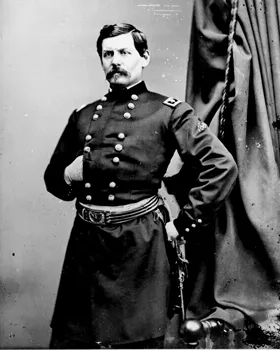
George B. McClellan, by Mathew Brady
In 1857, McClellan resigned from the army to become chief engineer and vice-president of the Illinois Central Railroad as well as president of the Ohio and Mississippi Railroad in 1860. He married Ellen Marcy in New York that same year. McClellan was opposed to Federal interference with slavery. He was approached by colleagues to side with the Confederacy, but he disagreed with secession. He returned to the military and was involved in two conflicts that were minor, but drew enough attention to make him a national hero.
He formed the Army of the Potomac and built defences for Washington DC that were nearly impregnable. They included 48 fortified positions with 480 guns manned by 7,200 artillerists. He favoured the Napoleonic style of campaigning which imposed minimal impact on the civilian population and would not require the emancipation of slaves. This was one of many things that put McClellan at odds with Abraham Lincoln.
The two men did agree on one thing. They opposed the Radical Republicans. McClellan was also at odds with Lieutenant General Winfield Scott to the point that Scott resigned to be replaced by McClellan as commander-in-chief of Union forces. But McClellan was again at odds with Lincoln when he refused to share details of his campaign strategies. He was also criticized for his overly cautious action in battle.
In March 1862, Lincoln relieved McClellan of his duty as commander-in-chief, leaving McClellan still in command of the Army of the Potomac. He retained that command until after the Battle of Antietam, the bloodiest single day of the war. When McClellan did not pursue Lee after the battle, Lincoln relieved McClellan of his command.
In October of 1863, McClellan declared for president. He was nominated by the Democratic Party as their candidate, but lost to Lincoln by a vast margin.
McClellan resigned his military commission on election day, 8 November 1864. After his defeat to Lincoln, he took his family to Europe where they remained for several years. He died at the age of fifty-eight in Orange, New Jersey, after having complained of chest pains for several weeks.
Robert Edward Lee (19 January 1807–12 October 1870)
Lee was another graduate of the United States Military Academy at West Point. Soldiering ran in the family; his father, known as ‘Light Horse Harry’ Lee, had been a hero of the Revolutionary War. Lee’s career as a combat engineer included service in the Mexican-American War, as superintendent of West Point and in leading the US Marines who arrested John Brown and his band of abolitionists at Harper’s Ferry in 1859.
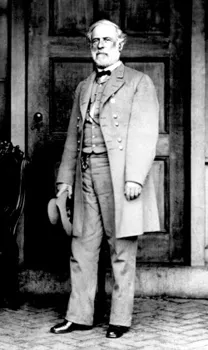
Robert E. Lee, by Mathew Brady
In 1831, he married Mary Anna Randolph Custis, the step-great-granddaughter of America’s first president, George Washington. Of their seven children, all three sons served in the Confederate army while his four daughters all died unmarried.
When Lee’s father-in-law, George Washington Parke Custis, died in 1857 he left his everything to his only child, Mary, Lee’s wife. The estate, which was poorly managed and in debt, and included hundreds of acres of land and hundreds of slaves, was in chaos, and the terms of Custis’ will required that all his slaves be emancipated within five years. Still, Lee and his wife managed, in spite of the war, to free all the slaves by 1862.
Besides his determination to liberate his father-in-law’s slaves, Lee supported his wife’s efforts to relocate freed slaves to Liberia, and supported her illegal school for slaves at Arlington Plantation. Lee further suggested, near the end of the war, that slaves should be enlisted into the Confederate army and emancipated in return for military service.
When war came, Lee was strongly conflicted. He saw secession as ‘revolution’ and told his son that it would bring ‘calamity’. Lee stated that he would never bear arms against the Union, but that he might find himself having to defend his native state of Virginia. Winfield Scott, commander of the Union forces, wanted Lee among his commanding officers, but on the day Lee received Scott’s offer, the State of Virginia seceded from the Union. Lee turned down the role of major general in the Union army to accept the same rank in the Confederate army. It was the end of a thirty-two-year career in the United States army. Even after being promoted to full general in the Confederate army, Lee continued to wear three stars on his uniform, the insignia of a colonel, the last rank he held in the US army.
Lee’s career throughout the war saw a series of successful tactical manoeuvres until Chancellorsville in 1863 when a brilliant plan by his general, Stonewall Jackson, was thwarted by Jackson’s accidental death at the hands of his own men. Lee’s next campaign was to take the battle north, into Pennsylvania. But when his men faced Union forces near the small market town of Gettysburg, three days of fighting marked a turning point in the war.
Shortly after Gettysburg, Ulysses S. Grant was appointed commander-in-chief of the Union forces, and Lee had finally met his match. Grant’s Overland Campa...
Table of contents
- Cover
- Title Page
- About History in an Hour
- Contents
- Introduction
- From One Revolution to Another
- Outline of the War
- The Leaders
- The Generals
- The War at Sea
- The Soldiers
- The Women
- The African-Americans
- War, the Mother of Invention
- The End Began Here
- The Fatal Blow
- War Crimes
- This Ends the Job
- Aftermath
- Appendix 1: Key Players
- Appendix 2: Timeline of the American Civil War
- Copyright
- Got Another Hour?
- About the Publisher